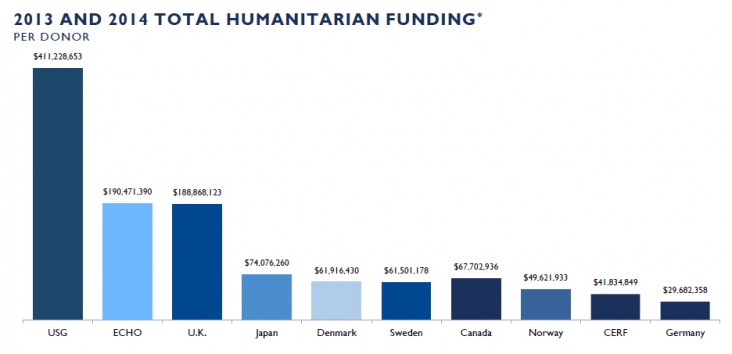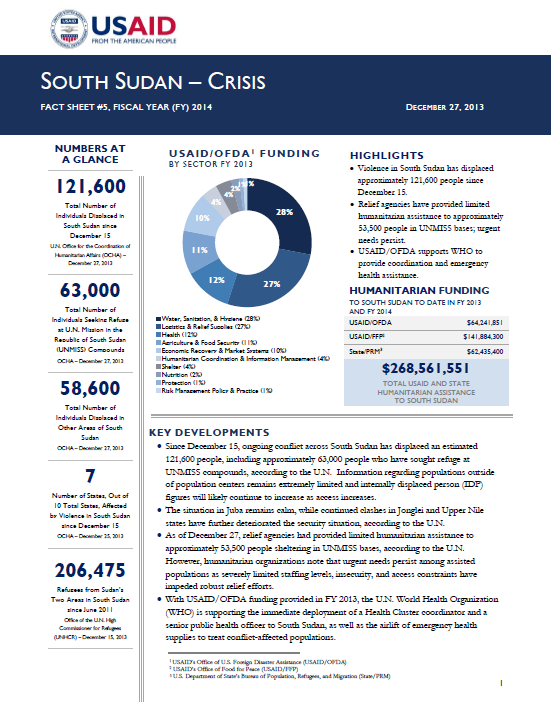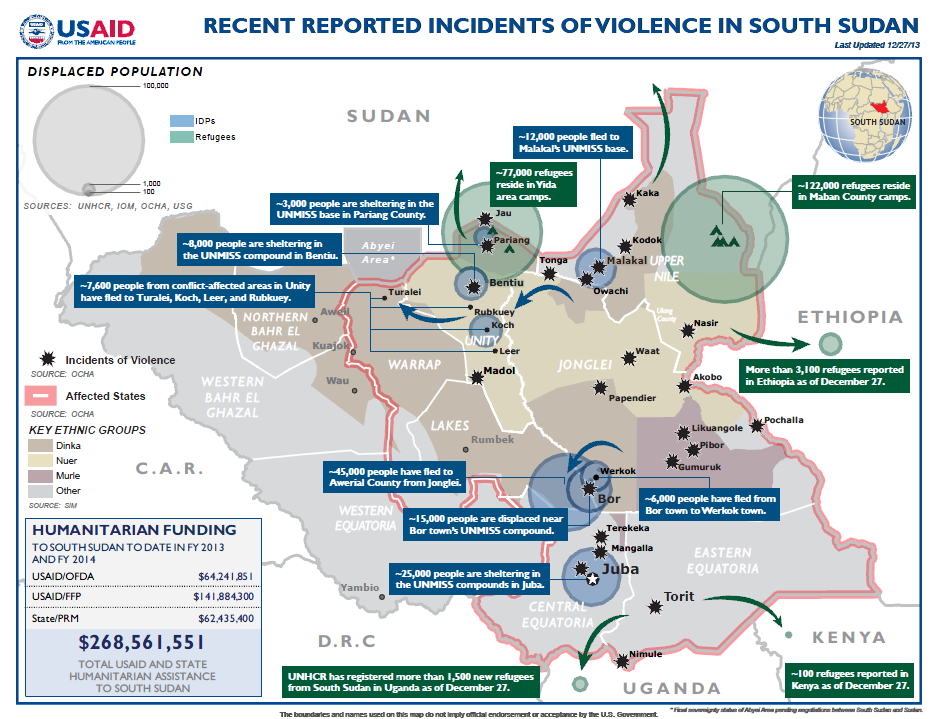- What We Do
- Agriculture and Food Security
- Democracy, Human Rights and Governance
- Economic Growth and Trade
- Education
- Environment and Global Climate Change
- Gender Equality and Women's Empowerment
- Global Health
- Humanitarian Assistance
- Transformation at USAID
- Water and Sanitation
- Working in Crises and Conflict
- U.S. Global Development Lab
Speeches Shim
May 16, 2014
Numbers At A Glance
998,900
86,000
912,900
237,700
237,700
Humanitarian Funding:
To South Sudan To Date In FY2014:
| USAID/OFDA | $60,775,086 |
| USAID/FFP | $35,000,000 |
| State/PRMDoD | $47,300,000 |
| TOTAL | $143,075,086 |
Highlights
The revised Crisis Response Plan (CRP) requests $1.8 billion through December.
Ceasefire fails to curb fighting, with clashes reported in Unity and Upper Nile states.
Current conflict has led to increased incidents of sexual and gender-based violence (GBV), according to the U.N. and advocacy organizations.
KEY DEVELOPMENTS
Despite President Salva Kiir and former Vice President Riek Machar’s recommitment to a cessation of hostilities on May 9, relief agencies and international media continue to report fighting between Sudan People’s Liberation Army (SPLA) and opposition elements in several areas of South Sudan, including in Unity and Upper Nile.
On May 15, relief agencies released a revised South Sudan CRP, which details countrywide humanitarian needs through December 2014. The revised CRP requests $1.8 billion to save lives and prevent famine, noting that the current crisis will likely displace nearly 2.4 million people, including 1.5 million internally displaced persons (IDPs), by the end of the year. To date, donors have provided approximately 33 percent of the revised appeal, leaving a shortfall of approximately $1.21 billion.
In response to deteriorating food security conditions and the recent IPC analysis estimate that 3.9 million people are likely to experience acute food insecurity by August, USAID/FFP partner the U.N. World Food Program (WFP) plans to expand emergency food assistance programming in South Sudan.4 WFP plans to target approximately 3.2 million people for food assistance, including 2 million people targeted by WFP’s emergency operation and 1.2 million people targeted by WFP’s protracted relief and recovery operation.
INSECURITY, DISPLACEMENT, AND ACCESS CONSTRAINTS
Despite the recent ceasefire agreement, security conditions remain fluid in South Sudan, with SPLA and opposition forces continuing to clash in areas of Unity and Upper Nile. The current conflict has displaced more than 1.3 million people—including 998,900 IDPs and 342,900 people who are seeking refuge in neighboring countries—since December 15. In addition, the U.N. reports that approximately 6,300 people have fled to Abyei Area.
Tensions remain high near Bentiu town, Unity; Renk town, Upper Nile; and Akobo town, Jonglei State, with clashes ongoing as of May 15 near Bentiu, according to international media. The U.N. reports that the number of IDPs sheltering at the Bentiu UNMISS base increased from approximately 25,000 people to 30,000 people between May 2 and 7.
Insecurity and poor airstrip conditions due to heavy rains in Bentiu have forced relief actors to suspend flights to the area, delaying the delivery of much-needed humanitarian cargo, according to WFP.
Meanwhile, the number of IDPs sheltering in the UNMISS compound in Bor town, Jonglei, has decreased since the beginning of May, according to the International Organization for Migration (IOM). Many IDPs reportedly fear a repeat attack on the civilian protection area and have fled Bor for Juba town, Central Equatoria State, or neighboring countries.
South Sudan Crisis Fact Sheet #42 May 16, 2014 ![]() (pdf - 264k)
(pdf - 264k)
South Sudan Crisis Map May 16, 2014 ![]() (pdf - 956k)
(pdf - 956k)
HUMANITARIAN NEEDS ASSESSMENTS AND RESPONSE ACTIVITIES
The U.N. Area Rapid Response Mechanism (ARRM)—led by the U.N. Children’s Fund (UNICEF), the U.N. Food and Agriculture Organization (FAO), and WFP—continues to provide much-needed humanitarian assistance to populations in remote locations. As of May 13, multi-sector rapid response teams had deployed to 10 of 24 planned locations, according to UNICEF. Through the ARRM, relief agencies have reached more than 39,000 children under five years of age with critical humanitarian assistance to date.
CAMP COORDINATION AND CAMP MANAGEMENT
The Camp Coordination and Camp Management Cluster (CCCM)—the coordinating body for humanitarian CCCM activities, comprising U.N. agencies, non-governmental organizations (NGOs), and other stakeholders—continues efforts to improve and expand existing protection of civilian (PoC) areas at UNMISS bases across South Sudan. A private company and relief actors continue to make progress on the construction of the new civilian protection area at the U.N. House UNMISS compound in Juba.
The CCCM Cluster continues to construct humanitarian hubs to facilitate relief work in remote locations. As of May 13, humanitarian hubs in Bentiu and Upper Nile’s Malakal town were nearing completion. In Malakal, IOM and partners had erected 14 tents with the capacity to accommodate 140 humanitarian staff. As of May 13, more than 50 relief workers from five organizations were using the tents for operations and accommodation.
AGRICULTURE, FOOD SECURITY, AND NUTRITION
On May 9, the USAID-funded Famine Early Warning Systems Network (FEWS NET) issued a food security alert, in line with preliminary IPC findings, predicting deteriorating levels of food security in the coming months in South Sudan due to ongoing conflict and resultant poor food security conditions—including high food prices, obstacles to accessing food, and market and trade flow disruptions. The alert warns that up to 4 million people will experience Crisis—IPC 3—or higher levels of food insecurity by the peak of the June-to-August lean season. Without urgent action, populations in some areas of Jonglei and Unity may experience Famine—IPC 5—levels of food insecurity. IDP and host community populations in Koch, Leer, Mayendit, and Panyijar counties, Unity; Ayod, Duk, Nyirol, and Uror counties, Jonglei; and Baliet and Panyikang counties, Upper Nile, will likely be among the most affected.
In response, USAID/FFP partner WFP plans to expand food assistance programming in South Sudan to target approximately 3.2 million people, including 2 million people through WFP’s emergency operation. WFP has already provided assistance to more than 700,000 people affected by the current crisis in 125 locations and will continue efforts to provide food assistance to conflict-affected and hard-to-reach populations via air, river, and road.
In addition, WFP plans to seek $17 million for a special operation in South Sudan to augment air transportation capacity before the end of May. The additional funding would allow WFP to scale up air operations as heavy rains are impeding road access to some areas.
Meanwhile, five WFP mobile distribution teams are operating in Lankien, Motot, Old Fangak, and Pibor towns, Jonglei; and Ganyel town, Unity, to prepare airdrop locations, register beneficiaries, receive food, and organize distributions. WFP provided emergency food assistance to nearly 450,000 people in April and plans to reach an estimated 900,000 people with food assistance in May.
With ongoing FY 2013 support, USAID/OFDA partner the Agency for Technical Cooperation and Development (ACTED) is improving agriculture production and food security in Jonglei and Warrap states. In Warrap, at least 64 percent of the population has inadequate access to food, according to ACTED. In response, ACTED organized six seed fairs during April in Warrap’s Gogrial West County, enabling seed traders to display, sell, and exchange seeds with farmers. Traders provided farmers with planting and harvesting advice and exhibited a variety of seeds, including groundnuts, maize, and sorghum.
HEALTH AND WASH
The Government of the Republic of South Sudan (RSS) Ministry of Health (MoH) issued a press release declaring a cholera outbreak in Juba on May 15. Although health actors have only confirmed one case of cholera to date, the MoH reports 18 suspected cases of cholera in Juba, including one death. The reported cases were not located in Juba’s UNMISS PoC sites. In response, health and water, sanitation, and hygiene (WASH) partners, in collaboration with the MoH, continue to conduct cholera vaccination campaigns and disseminate hygiene promotion messages.
Health actors have completed oral cholera vaccination campaigns in IDP sites in Malakal; Mingkaman, Lakes State; and in Juba’s Tong Ping and U.N. House PoC areas, according to UNICEF. As of May 8, relief actors had provided cholera vaccinations to more than 2,700 people in the Bor PoC site. In addition, UNICEF has pre-positioned diarrheal disease kits in Bentiu, Bor, and Malakal, and developed a multi-sector response plan in accordance with the RSS national framework for strengthening cholera preparedness and response.
Acute respiratory infection, acute watery diarrhea, and malaria were the main causes of mortality during the week of May 6, according to UNICEF. The incidence rate of measles is declining, likely due, in part, to recent integrated measles and polio vaccination campaigns and ongoing measles vaccination campaigns, UNICEF reports. Between December and mid-May, the Health Cluster had administered measles vaccines to nearly 263,400 internally displaced children under the age of fifteen.
With UNICEF support, WASH Cluster partners in Bor are providing IDPs with approximately 18 liters of safe drinking water per person per day and continue efforts to construct new latrines to improve sanitation conditions following the recent collapse of 80 latrines in the PoC site due to heavy rain.
The WASH Cluster continues to provide IDPs in Tong Ping with 20 liters of safe drinking water per person per day, exceeding the Sphere[1] standard of 15 liters per person per day. In addition, UNICEF-funded solid waste disposal and latrine maintenance is benefiting more than 21,000 IDPs at the Tong Ping PoC site.
USAID/OFDA recently provided $255,000 to international NGO CARE through the IOM-managed Rapid Response Fund (RRF), to support the health and WASH needs of vulnerable IDPs at the PoC site in Bentiu. The funding will provide support for emergency latrines, hygiene promotion activities, and health care support for IDPs at the site.
LOGISTICS AND RELIEF COMMODITIES
Between May 7 and 14, the Logistics Cluster airlifted approximately 59 metric tons (MT) of humanitarian cargo, including health and WASH supplies, to five locations, including Old Fangak town, Jonglei; Ganyiel, Mayendit, and Nyal towns, Unity; and Malakal.
The Logistics Cluster is encouraging partner organizations to focus on long-term planning for the humanitarian response. To enhance response capacity, the Logistics Cluster is standardizing all warehouse-related procedures and plans to procure additional mobile storage units to increase humanitarian storage capacity within South Sudan.
With support from the Logistics Cluster, UNICEF transported health, nutrition, and child protection supplies via helicopter from Rumbek town, Lakes State, to partners in Mayendit and Nyal.
IOM-operated common transport service—a service that allows partners to transport humanitarian supplies across South Sudan free of charge—trucks moved approximately 45 MT of humanitarian cargo, including health and WASH supplies, to various locations in six of South Sudan’s 10 states between May 6 and 13.
PROTECTION
The recent conflict in South Sudan has exacerbated sexual violence and GBV, according to the U.N. Both SPLA and opposition actors have committed atrocities against civilians—including rape and sexual violence—in Juba and areas of Jonglei, Unity, and Upper Nile, according to a recently released Amnesty International report.
A May 13 Inter-Agency Standing Committee—a mechanism for inter-agency coordination involving U.N. and non-U.N. humanitarian agencies—alert reports that the crisis has increased the exposure of girls and women to protection- and health-related risks, such as GBV. The alert highlights the need to include women and girls in response activities and provides guidelines for integrating gender equality into ongoing humanitarian response efforts.
To date, USAID/OFDA partner UNICEF and partners have reached more than 30,000 children with critical child protection services since the beginning of the crisis. In addition, child protection experts continue to provide psychosocial support at 25 child friendly spaces in Central Equatoria, Lakes, Jonglei, Unity, and Upper Nile, benefiting more than 9,200 children.
OTHER HUMANITARIAN ASSISTANCE
Humanitarian actors released a revised CRP on May 15, which details countrywide humanitarian needs through December 2014. The new CRP requests $1.8 billion to save lives, prevent famine, and “avert the loss of another generation of South Sudanese children.” To date, the humanitarian community has provided approximately $589 million toward the revised CRP—nearly 33 percent of the $1.8 billion total requested funding, leaving a shortfall of approximately $1.21 billion.
On May 14, the Government of Norway (GoN) announced an increase of nearly $28 million for humanitarian assistance for several acute emergencies worldwide. A portion of the new GoN contribution will fund relief activities in South Sudan, including support for food assistance, medical care, protection, safe drinking water, and shelter. As of May 16, the GoN had already provided more than $18 million in humanitarian assistance to South Sudan in 2014.




Comment
Make a general inquiry or suggest an improvement.